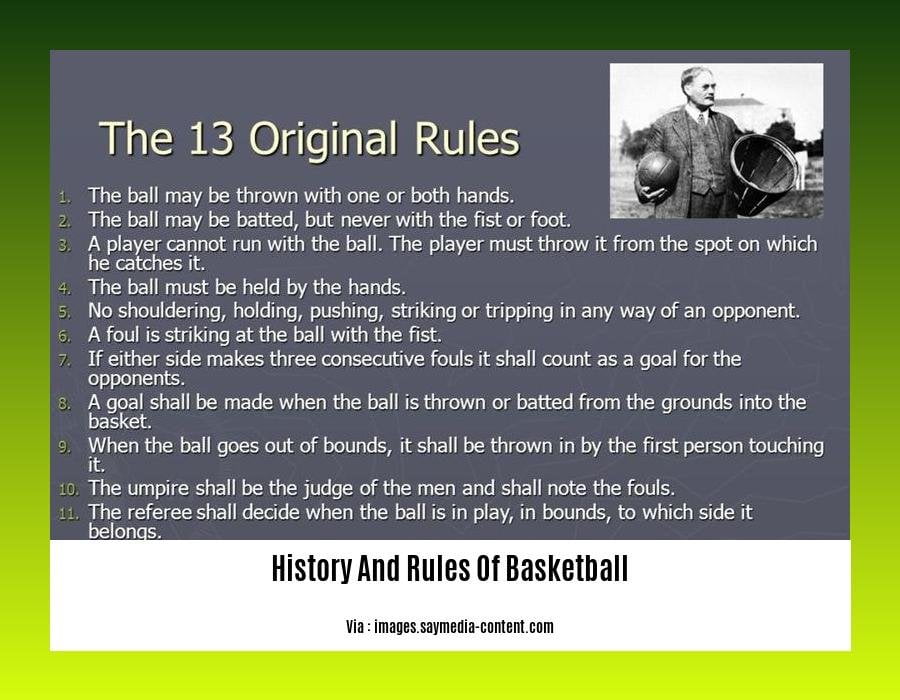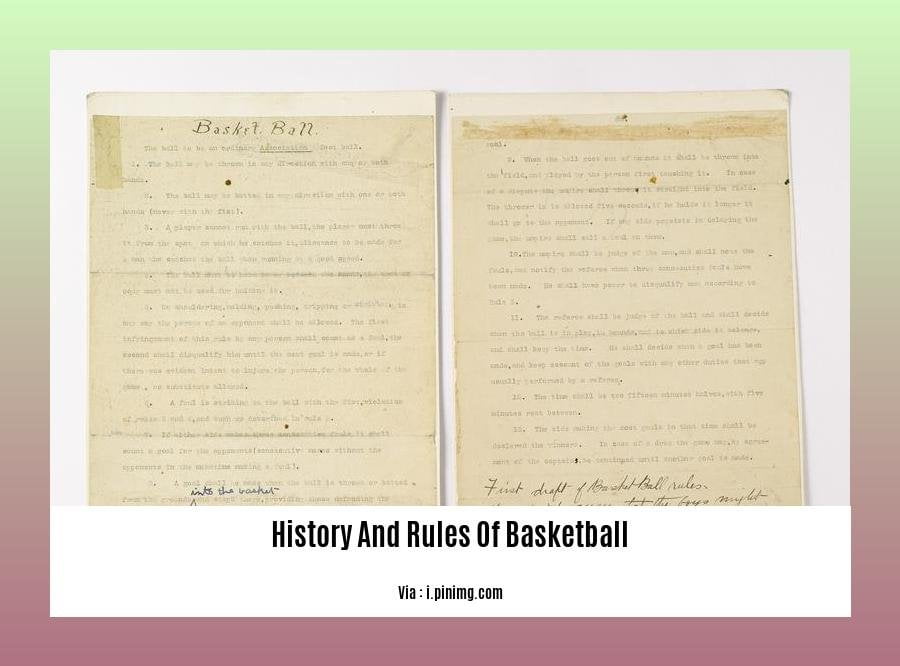In the tapestry of sports, few hold a candle to the captivating allure of basketball. From its humble beginnings in a Massachusetts YMCA to its current status as a global sensation, the game has come a long way. In this article, we embark on a journey through the annals of basketball’s history, tracing its evolution from James Naismith’s original rules to the modern era, exploring the intricacies of its rules, and delving into the factors that have shaped its enduring legacy.
Key Takeaways:
- Basketball is a team sport played between two teams of five players on a rectangular court.
- The goal is to score points by throwing the ball through the opponent’s basket.
- James Naismith invented basketball in 1891 as a safer alternative to football.
- The sport quickly spread across the United States and the world in the early 20th century.
- The National Basketball Association (NBA) was formed in 1946.
- Basketball is one of the most popular sports globally, played by millions of people.
History and Rules of Basketball: Unveiling the Foundations of a Global Sport

The captivating tale of basketball unravels amidst the halls of the YMCA in Springfield, Massachusetts, where, in 1891, Dr. James Naismith, driven by a desire to create a less perilous alternative to the bruising sport of football, conjured up this iconic game. With thirteen modest rules, a peach basket, and a soccer ball, Naismith laid the groundwork for a sport destined for global adoration.
A Shot Toward Global Dominance: How Basketball Transcended Borders
In the early 20th century, basketball soared beyond the boundaries of Springfield, captivating regions across the United States and igniting a global passion. The formation of the National Basketball Association (NBA) in 1946 marked a pivotal juncture, propelling the sport into the realm of international prominence. Today, millions of enthusiasts spanning every corner of the globe relish the thrill of basketball, weaving it into the rich tapestry of their lives.
Deciphering the Dynamics of Basketball: A Journey Through the Rules
Unveiling the intricacies of basketball’s rulebook unveils a world of strategic nuances and captivating plays. Here, we present a simplified breakdown of its fundamental principles:
– Objective: Achieve victory by sinking the ball through the opponent’s hoop more times than they score through yours.
– Team Composition: Each team fields five players simultaneously, with substitutions permitted throughout the game.
– Court Dimensions: The rectangular court boasts a length of 94 feet and a width of 50 feet.
– Game Duration: A regulation game consists of four quarters, each lasting 12 minutes of uninterrupted play.
– Scoring: Successful shots within the three-point arc yield one point, while those beyond this designated zone are worth three points.
– Fouls: Players are cautioned against committing fouls, which are penalized with free throws awarded to the opposing team.
– Traveling: Players must dribble the ball while moving or risk losing possession due to traveling violations.
– Double Dribble: Re-dribbling after picking up the ball constitutes a double dribble and results in a turnover.
– Overtime: In the event of a tie score at the end of regulation, an overtime period ensues, extending the game until a victor prevails.
Embarking on this journey of discovery has illuminated the origins and governing principles of basketball, a sport that has enthralled generations of athletes and fans across the globe. From its humble beginnings in a Massachusetts gymnasium to its status as a global phenomenon, basketball’s captivating allure endures, uniting communities and igniting passions wherever it graces the court.
- Want to learn the deep-rooted genesis of African traditional dances? Delve into the fascinating history of Adowa dance and uncover its cultural significance.
- Embark on a journey through time as we explore the history of accounting SS1, tracing the evolution of this essential financial practice from its ancient origins to its modern-day applications.
Original rules

In December 1891, James Naismith, a Canadian physical education instructor at the YMCA in Springfield, Massachusetts, invented basketball as a less injury-prone sport than football. Naismith’s original rules were simple and straightforward, designed to promote teamwork, skill, and fair play.
Evolution of Basketball Rules:
- 1891: The first set of 13 original rules were established by James Naismith.
- 1894: The number of players on each team was increased from 9 to 5.
- 1895: The game was divided into two halves, each lasting 15 minutes.
- 1897: The center jump was introduced.
- 1904: The backboard was added to prevent players from batting the ball out of bounds.
- 1909: The free throw line was established.
- 1912: The dribble was legalized.
- 1936: The 3-second rule was introduced to prevent players from camping out in the paint.
- 1949: The shot clock was introduced to speed up the game.
- 1979: The 3-point line was added to encourage more outside shooting.
Original rules of Basketball:
The original rules of basketball, as published by Naismith in 1892, were as follows:
- The ball could be thrown or batted in any direction with one or both hands, never a fist.
- A player could not run with the ball but had to throw it from the spot where it was caught.
- Players were not allowed to push, trip, or strike their opponents.
- The ball could be held in or batted out of bounds, but could not be kicked, punched or carried.
- A foul was called when a player violated any of the rules.
- The game was played in two 15-minute halves with a 5-minute break in between.
- The team that scored the most points won the game.
Key Takeaways:
- The original rules of basketball were established by James Naismith in 1892.
- The original rules were designed to promote teamwork, skill, and fair play.
- The rules of basketball have evolved over time to make the game more exciting and challenging.
- Basketball is now one of the most popular sports in the world.
Sources:
**History of Basketball**
Basketball, a captivating global sport, has a rich and storied history that dates back to the late 19th century. Its humble beginnings can be traced to the mind of Dr. James Naismith, a Canadian physical education teacher at the YMCA Training School in Springfield, Massachusetts. In December 1891, seeking an indoor game to keep his students active during the long New England winters, Dr. Naismith nailed a peach basket to a balcony 10 feet high and introduced a new game called “Basket Ball.”
Key Rules of Basketball
Dr. Naismith’s original rules, designed to promote teamwork and fair play, were remarkably similar to those used in the modern game.
-
Players: Each team comprised nine players initially, reduced to seven in 1894, and eventually standardized at five players per team in 1897.
-
Court: The court was rectangular, with two baskets placed at each end.
-
Objective: The goal was to score points by throwing the ball into the opposing team’s basket.
-
Fouls: Fouls were called for violations such as holding the ball, pushing, or striking an opponent.
Evolution of Basketball
From its modest origins, basketball’s popularity spread rapidly, thanks to its fast-paced action, teamwork emphasis, and accessibility. The game’s rules evolved over time to enhance its excitement and competitiveness.
-
1895: The game was divided into two 15-minute halves.
-
1909: The free-throw line was established 15 feet from the basket.
-
1912: Dribbling was introduced, allowing players to advance the ball by bouncing it while running.
-
1936: The three-second rule was implemented, limiting the time a player could hold the ball in the paint.
-
1946: The National Basketball Association (NBA) was founded, revolutionizing the sport’s professional landscape.
-
1979: The three-point line was introduced, adding a new dimension to the game and rewarding long-range shooting.
Basketball Today
Today, basketball stands as one of the most popular sports worldwide, played by millions of people in countries across the globe. Its international appeal is evident in the success of the FIBA World Cup, the Olympics, and the NBA’s global reach. Basketball has become a cultural phenomenon, inspiring movies, video games, fashion trends, and a vibrant sneaker culture.
Key Takeaways:
-
Basketball was invented by Dr. James Naismith in 1891 as an indoor game for YMCA students.
-
The game’s popularity grew rapidly due to its fast-paced action, teamwork emphasis, and accessibility.
-
The rules of basketball have evolved over time to enhance excitement and competitiveness, including the introduction of dribbling, the free-throw line, the three-second rule, and the three-point line.
-
Basketball has become a global phenomenon, played by millions of people worldwide and inspiring a vast array of cultural expressions.
Sources:
The History of Basketball
FAQ
Q1: Who invented basketball and in what year?
A1: Basketball was invented by James Naismith in 1891 in Springfield, Massachusetts.
Q2: What were James Naismith’s original rules for basketball?
A2: Naismith’s original 13 rules included: a court divided into two halves, two teams of nine players, a ball that could be thrown in any direction, no running with the ball, and a goal scored by throwing the ball into a peach basket.
Q3: How did the game of basketball evolve from its early days?
A3: Over time, the number of players on a team was reduced to five, the peach baskets were replaced with metal hoops and backboards, and the game became faster-paced and higher-scoring.
Q4: What are some of the most significant changes to the rules of basketball over the years?
A4: Some notable changes to the rules of basketball include the introduction of the three-point line, the shot clock, and instant replay.
Q5: How has basketball become a global sport?
A5: Basketball’s popularity spread around the world in the early 20th century, thanks to touring teams, the Olympics, and the formation of international basketball organizations like FIBA. Today, basketball is played in over 200 countries and is one of the most popular sports in the world.
- Unveiling Bernhard Caesar Einstein’s Scientific Achievements: A Legacy in Engineering - July 15, 2025
- Uncover who is Jerry McSorley: CEO, Family Man, Business Success Story - July 15, 2025
- Discover Bernhard Caesar Einstein’s Scientific Contributions: Unveiling a Legacy Beyond Einstein - July 15, 2025















